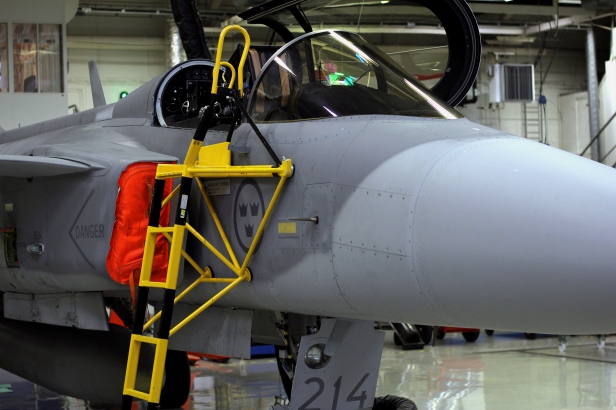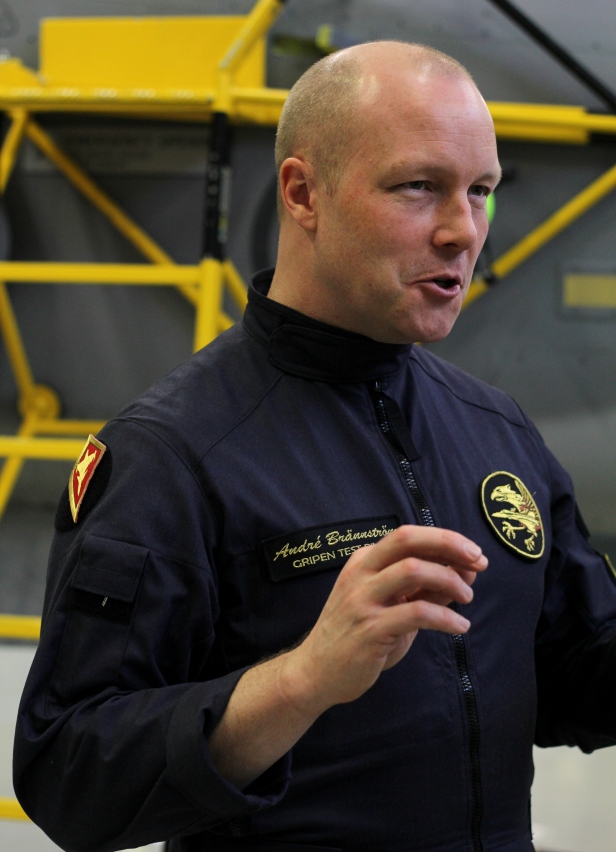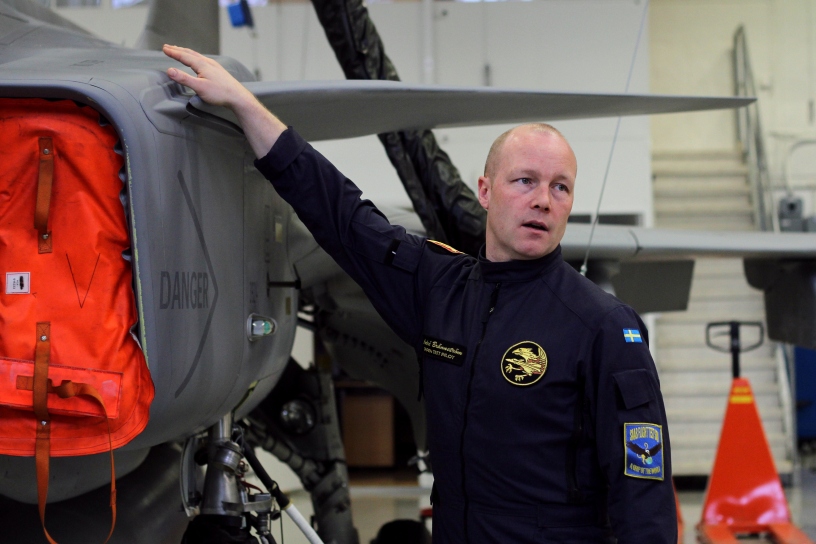One of the more interesting encounters during my visit to Saab was with one of the seven test pilots Saab has. André Brännström is a former Swedish Air Force pilot, who started his career flying the J 35 Draken in the early 90’s, before moving on to the JA 37 Viggen and eventually the JAS 39 Gripen. Having been part of the air force’s OT&E (Operational Test and Evaluation) unit charged with testing out new upgrades and procedures and developing tactics and practices to account for these, he eventually transitioned over to Saab three years ago. Flight testing at Saab includes both ‘technical’ (the testing all aircrafts have to go through) as well as ‘tactical’ flight testing (testing out new weapons and improvements to the sensors and avionics of the aircraft). For the latter, Saab has a complete assortment of the dummy versions of Gripen’s weapons. This places demands on the pilots to keep up to date with how the air force operates their fighters, and Brännström still occasionally flies for the air force to keep in touch with the operator’s point of view.

One example of the later was the exercise ACE15 last year, where he amongst other things got to meet a Finnish F/A-18C Hornet in a 1-vs-1 scenario in the skies over Lapland, something which we Finnish visitors were eager to hear more about.
“Well” he explained, “the Hornet is a good aircraft. But this was a rather young pilot, and I know where I want my Gripen to be. Speed, altitude, if I get him there, well…”
We decided to leave the topic there.
In the hangar were we met, a single JAS 39C stood parked. ‘39214’ sported the cat paw of the Såtenäs-based F 7 Skaraborg Wing, and represented the latest standard in 39C development, what Saab calls the Edition 20. In practice, this means that the aircraft features improvements to the radar and adds the capability to employ METEOR long-range air-to-air missiles and GBU-39 Small Diameter Bombs, a 110 kg guided bomb with pop-out wings that give it the ability to glide towards it target, both of which will be key weapons in the arsenal of the 39E when it enters service. The Edition 20 is to be introduced in regular service within the next few weeks.

The editions represent the Saab way of handling upgrades to the aircraft. Instead of taking major leaps in the form of one or two mid-life updates during the lifetime of an aircraft, they roll out smaller updates at regular intervals. The idea behind this is that the fighter should be at its best all the time, and not only during the first years after the update, as well as to lessen the technological risk. The pressure to include new features of uncertain long-term value and unproven technology becomes smaller when both customer and supplier knows that it is a shorter time to the next round of improvements. This is made possible due to the tight cooperation between the Air Force, the Swedish Defence Materiel Administration (FMV), and Saab, as evident by the fact that Saab is able to “borrow” (there are certainly both money and contractual issues involved) operational aircraft such as ‘39214’ for testing, while the air force can borrow test pilots if the need arises. Nowhere is this close collaboration more visible than in Linköping itself, which houses not only Saab (at the Linköping City Airport), but also FMV’s Flight Test Centre Linköping (co-located with the Swedish Air Force’s Helicopter Wing at the Malmen Airbase).
Besides the aircraft lay two dummy IRIS-T short-range air-to-air missiles. The IRIS-T belongs to the new generation of highly agile missile, making shots over the shoulder possible with the use of a helmet-mounted display, a piece of gear described by Brännström as “great”. When talking about the impact of high off-boresight missiles such as the IRIS-T and the AIM-9X currently used by Finnish F/A-18C, it was clear that they were game changers:
“No longer can you be safe just because you’re here”, explained Brännström and indicated one fighter behind another one. “There are certain differences I can’t talk about [between the AIM-9X and the IRIS-T], but this [the IRIS-T] is the one I’d buy.” Presumably the proliferation of agile air-to-air missiles have also lead to the fact that sustained turn rate, one of Gripen’s strong points, have increased in importance relative to instantaneous turn rate. The Gripen, like most modern fighters, is built so that the pilot doesn’t have to move his hands at any point during air combat maneuvers, with all necessary switches and controls being found on the throttle lever and control stick. Hard maneuvers are further simplified by the control systems, which automatically limits steering and throttle output based on the current load condition to make sure that the aircraft (or external stores) isn’t overstressed, allowing the pilot to pull the stick and lever as hard as he wants to, knowing that he won’t break anything.
The data link capability is something Saab is very proud of, and while many fighters today can share information through the use of systems such as Link 16, the Gripen has some further unspecified additional capability as well, causing Brännström to reflect that in a mixed formation with different fighters, “I believe I’d be the happiest one.”


